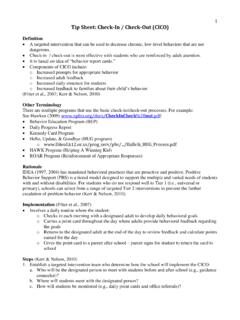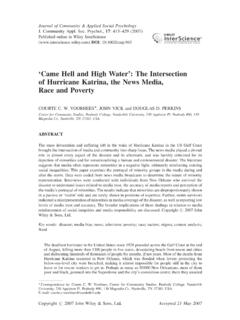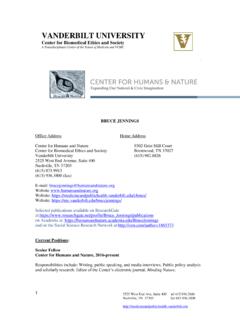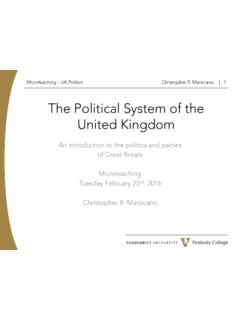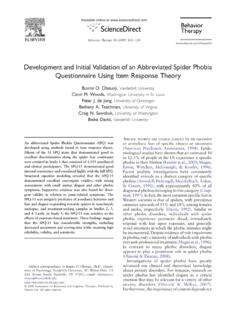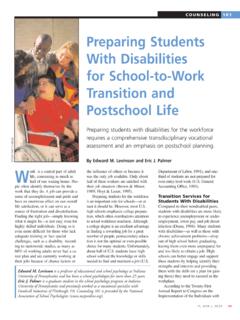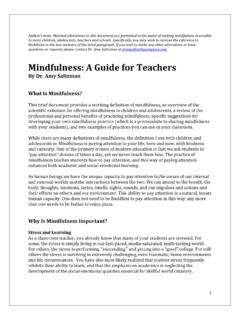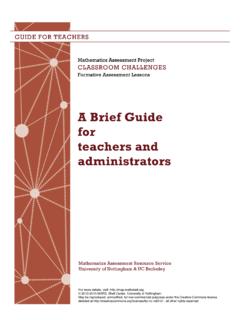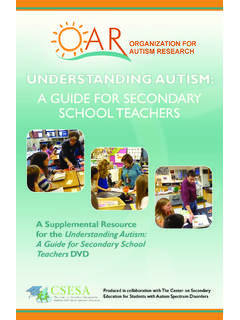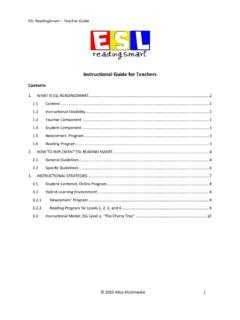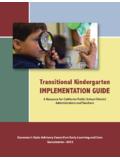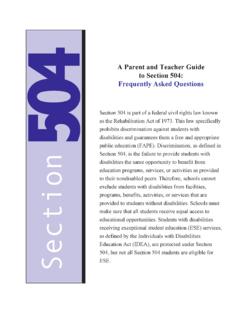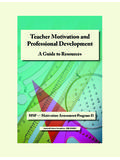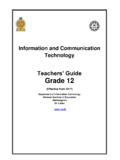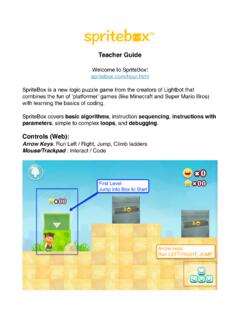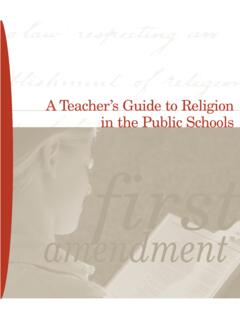Transcription of Literacy teaching guide: Phonics - my.vanderbilt.edu
1 PhonicsLiteracy teaching guide : PhonicsNSW Department of Education and TrainingLearning and DevelopmentThe Literacy teaching guide : Phonics and the Literacy teaching guide : Phonemic awareness are companion guides and as such should be read in conjunction with each Literacy teaching guide : Phonics and the Literacy teaching guide : Phonemic awareness are companionguides and as such should be read in conjunction with each teaching guide :PhonicsLiteracy teaching guide : PhonicsPage 2 State of New South Wales through the Department of Education and Training, 2009. This workmay be freely reproduced and distributed for personal, educational or government must be received from the Department for all other Under NEALSISBN 9780731386093 SCIS 1363832 Literacy teaching guide : PhonicsPage 3 ForewordThis teaching guide on Phonics is one of a series of connectedresources to support Literacy resources incorporate the most recent research on Literacy andliteracy education, the findings of national and international reviewsand teachers experience with, and feedback on Literacy supportmaterials that the Department has produced in the guide needs to be read and used in conjunction with that onphonemic awareness, which has been simultaneously published.
2 Thesetwo critical aspects of Literacy need to be taught and learned teaching of Phonics has been the subject of some public debate. The Department s position isclearly stated in our Literacy Policy, namely, that Phonics should be explicitly and systematicallytaught, within an integrated and balanced guide reaffirms that principle. Indeed, with the benefit of research and experience, it articulateseven more strongly the need for explicit and systematic a c h e r s u s i n g t h i s g u i d e w i l l f i n d a s i g n i f i c a n t b o d y o f e v i d e n c e - b a s e d i n f o r m a t i o n t o s u p p o r t t h eteaching and learning of Phonics . The guide examines and debunks some of the commonly heldmisconceptions or myths about teaching Phonics . It recommends a sequence for the teaching ofphonics knowledge and skills and presents a process that supports teachers to teach Phonics in anexplicit and systematic way, as part of a balanced and integrated Literacy program.
3 Teachers will alsofind practical ideas and suggestions to enhance their Phonics support for the teaching and learning of Phonics is available in the form of a LiteracyContinuum. This continuum sets out eight critical aspects of Literacy and their developmentalmarkers. Phonics is one of these critical aspects. A further online professional learning resource,that is linked to the Phonics aspect of the continuum will provide teachers with Phonics feedback and suggestions on this guide would be appreciated. As this resource will be online,it will be regularly revised. Your comments should be emailed to: the teaching of Phonics is essential, no one aspect of Literacy learning is sufficient tobecoming literate. Effective Literacy teaching includes all aspects critical to successful literacydevelopment, within a balanced and integrated commend this teaching guide to you and wish you every success as you work with your colleaguesto improve the learning of your FletcherDeputy Director-General, SchoolsLiteracy teaching guide : PhonicsPage 4 Literacy teaching guide : PhonicsPage 5 ContentsIntroduction6 Purpose6 Links to the Literacy Continuum6 About this guide7 Exposing Phonics myths8 Catering for student diversity when teaching phonics10 About Phonics teaching12 Principles of effective Phonics teaching12 Phonics methods15 Sequencing Phonics instruction16 The NSW English K 6 syllabus and the Four Literacy Resources model20 Being explicit and systematic about teaching Phonics in a balanced andintegrated Literacy program22 Three key strategies.
4 Modelled, guided and independent teaching24 Early years teachers talk about teaching Phonics in their Literacy sessions26 Explicit Phonics teaching in action29 Navigating this section of the guide29At a glance: The Phonics aspect of the Literacy Continuum30A process for explicit and systematic Phonics teaching31 The process in action: Phonics32 Bibliography48 Appendices50 Appendix 1 Glossary50 Appendix 2 Websites for additional information and support53 Appendix 3 Supporting students with significant difficulties in learning to read54 Appendix 4 Supporting Aboriginal students55 Appendix 5 Supporting students who are learning English as a secondlanguage (ESL)56 Appendix 6 Supporting students from low socio-economic backgrounds57 Appendix 7 The Four Literacy Resources model58 Appendix 8 Linking the NSW English K 6 syllabus and the Literacy Continuum59 Appendix 9 Ideas for practising and applying Phonics learning63 Literacy teaching guide : PhonicsPage 6 IntroductionPurposeThis resource has been developed to help teachers gain deeper insights into theteaching of Phonics .
5 It offers advice on why and how to teach Phonics andprovides a range of teaching and learning strategies to develop students Phonics knowledge and simple terms, Phonics involves knowing the connections between printedletters (and combinations of letters) and speech sounds. For example, studentsshow their Phonics knowledge when they are asked to point to the letter mand provide the sound it instruction involves teaching students to know the relationshipsbetween letters and sounds and how to use this knowledge to recognise wordswhen reading, and to spell words when argue about how much emphasis should be placed on phonicsinstruction, but just about all agree that Phonics is one of the aspects of literacycritical to successful Literacy 2 from the National Inquiry into the teaching of Literacy (2005) states that:.. teachers provide systematic, direct and explicit Phonics instruction so thatchildren master the essential alphabetic code-breaking skills required forfoundational reading proficiency.
6 Equally, that teachers provide an integratedapproach to reading that supports the development of oral language,vocabulary, grammar, reading fluency, comprehension and the literacies ofnew , Phonics should be taught explicitly and systematically as part of abalanced and integrated Literacy to the Literacy ContinuumEarly years teachers will be familiar with the early Literacy continuum used in theBest Start critical aspects of Literacy form the foundation of this continuum. Phonicsis one of these continuum describes the development of Literacy knowledge and skillstypically expected of most students in these eight critical each critical aspect key developmental points are signalled by clusters ofmarkers along the , The process in action: Phonics (pp. 32 47) in this guide is organisedaround each cluster of Phonics involvesknowing theconnectionsbetween printedletters and is one ofthe aspects ofliteracy critical tosuccessful teaching guide : PhonicsPage 7 About this guideThis guide is one in a series, each dealing with a critical aspect of in the series focus on: Phonemic awareness Vocabulary knowledge Aspects of speaking Concepts about print Aspects of writing Comprehension Reading : Other crucial areas of Literacy , such as grammar, spelling, punctuation andlistening are developed within a number of the above is important that this guide on Phonics (knowing letter-sound relationships) isused in conjunction with the Literacy teaching guide : Phonemic awareness(manipulating sounds in words).
7 Phonics and phonemic awareness are closely related. Learning about one aspectreinforces the other. Both are concerned with sounds, with phonemicawareness involving spoken language and Phonics involving written example, you are asking your students to show their phonemic awarenesswhen you say mat and ask them to say the three separate sounds they hear inthe guide and each of the other guides, will be supported by a summary of theliterature upon which the advice in the guide is guide avoids the use of technical language however, at times, it has beennecessary to use terms that are specifically related to the teaching of Phonics . Aglossary has been provided at Appendix 1 to define these andphonemicawareness areclosely aboutone reinforces teaching guide : PhonicsPage 8 Exposing Phonics mythsFor decades now, the teaching and learning of Phonics has been the subject ofdebate. It seems everyone has an opinion, so much so that a host of mythsabout Phonics teaching and learning have almost become accepted as some of these commonly held myths is intended to prompt teachersto examine and reflect on their classroom practices in light of the informationabout Phonics teaching provided in this of the more common myths about teaching Phonics are listed below initalics together with statements in bold that debunk these : Reading is primarily about decoding symbol to sound.
8 If students are thoroughly taughtevery possible letter-sound relationship and their various combinations, they will becomeproficient readers and the basis of a comprehensive synthesis of findings from the related evidence-basedresearch, Center (2005) notes that the systematic, explicit teaching of Phonics is anecessary condition but not a sufficient condition for the teaching of reading. Sincereading essentially involves two basic and complementary processes: learning how todecipher print and understanding what the print means, an integrated approach toreading instruction is instruction is never a total reading that focus too much on the teaching of letter-sound relationships and notenough on putting them to use are unlikely to be very effective. In implementingsystematic Phonics instruction, .. educators must keep the end (original emphasis) inmind and ensure that children understand the purpose of learning letter-sounds andare able to apply their skills in their daily reading and writing activities (NationalInquiry into the teaching of Literacy , 2005).
9 Myth: teaching the class one letter-sound relationship per week (oftenintroducing these letter-sounds in order of the alphabet) is an effective wayto start teaching Phonics in guide provides teachers with a sequence for Phonics teachingthat facilitates the use of the synthetic Phonics . This methodencourages teachers to introduce particular groups of letter-soundcorrespondences that will allow Kindergarten students to beginblending and segmenting words as soon as possible. For example, inthe sequence on p. 17, the first four letters introduced would be a, m,t and : Students should first learn all single letter sounds before they aretaught the names of letters to avoid students confusing letter names often learn letter names before they learn letter it is sometimes advised to leave the teaching of letternames until after the sounds of letters have been learned, it makessense to teach letter names early in the Phonics program. Thedifference between a letter name and a letter sound is easilyunderstood by most teaching guide : PhonicsPage 9 Myth: Phonics , phonemic awareness and phonological awareness are one and the same thing they all have something to do with sounds and/or three terms are closely related with learning in one area reinforcing the , the three terms are not the same or interchangeable.
10 Phonologicalawareness is a broad concept that not only includes phonemic awareness but alsoencompasses awareness of things like words, rhyme, syllables and onset and awareness is a sub-skill of phonological awareness. Phonemic awareness isthe ability to hear and manipulate sounds in spoken words while Phonics involvesmaking connections between sounds and letters when reading and : Students need to know all letter-sound relationships before they beginlearning about other aspects of Literacy , such as number of aspects of Literacy are critical to early Literacy is one of these aspects. As part of a balanced and integratedliteracy program, students need explicit teaching in other criticalaspects of Literacy such as comprehension, at the same time as theyare learning about Phonics . Development of skills and knowledge inone aspect of Literacy complements and supports the : In the early years most of the Literacy session time, that isapproximately one and a half hours per day, should be devoted just tophonics activities (sometimes in the form of a commercial Phonics program).
